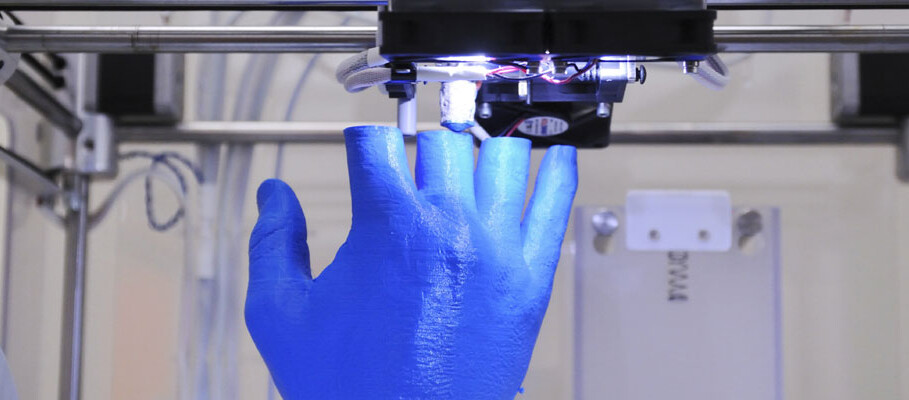How long have 3D printers been around?
Believe it or not, industrial 3D printing machines have been around since the early 1980s. However, it was Charles Hull who first applied for a patent for the 3D printer in 1986. Early 3D printing machines were initially used in the aircraft and automotive industries as well as for the military. In 2009, it was finally time for service providers to also carry out commissioned work. The private early adopters were designers and artists, who wanted to use 3D printing to produce their prototypes as quickly and efficiently as possible.
How does 3D printing work?
3D printers are not “ordinary” printers. They do not function two-dimensionally, rather they build three-dimensional objects – razor-thin and layer by layer by adding or applying material. For a long time, 3D printing has not only used plastic, but also stainless steel, aluminium, titanium, and cobalt-chrome. The use of biomaterials is also becoming more common.
Unlike the "subtractive processes" where the milled, turned, or drilled material is removed from the object, 3D printing is therefore referred to as "generative processes" or "additive manufacturing." A digital model almost always acts as a template. This is typically in the form of a CAD file (Computer Aided Design), which is converted into machine-readable code.
What are the advantages and disadvantages of 3D printing when compared to conventional printing methods?
3D printing enables the creation of structures and shapes that are not possible with conventional methods. In many cases, replacement parts are required for installations, which are so old that repair kits are simply no longer available or produced for them. In these cases, engineers can scan the defective parts and then reproduce them on the computer. 3D printers also make it possible to recreate structures found in nature. Up to now, this so-called “bionic design” could only be used to a limited extent.
Materials generated by a 3D printer cool and solidify faster, have finer grit, and are often lighter. Although the object is manufactured from powder or liquid, the end result is just as strong and durable as a traditionally crafted item. Furthermore, barely any material is used than what is required for the part. Thanks to 3D printing, almost every conceivable geometric shape can be made; the design flexibility is significantly greater. Another advantage is speed: Custom-made products that are only available after several days or weeks through the conventional production process can be manufactured within a few hours using additive manufacturing.
However, in certain cases, it has turned out to be a disadvantage as printed metal is less elastic and therefore more likely to break. Besides that, today's 3D printing does not yet meet industrial requirements for surface technology, especially metal-based materials. For mass production, the process is too time-consuming and still too expensive for the majority of products.
In which areas is 3D printing used?
Even in 2023, 3D printers are still too complex for mass production. Nevertheless, development is well underway: Today, houses are built, tools are manufactured, and even living tissue is printed with additive manufacturing. The technology has become widely accepted, especially in industry. In addition to the printing of prototypes (rapid prototyping), series production is also increasingly benefiting from 3D printing. Prototypes are more widely used in industries like mechanical engineering, medicine, design, and architecture.
The technology also demonstrates its strengths in custom-made production. Here, 3D printing helps to manufacture (rare) replacement parts, individual dental crowns, and hearing aids or even pieces of jewellery. One major advantage of 3D printing is its flexibility: For example in aerospace, replacement parts can be conveniently manufactured on-site, eliminating the need for long delivery times. Or, even simpler: Damaged tools or other objects can be repaired with the help of 3D printing; the damaged areas can simply be rebuilt.

Industry is increasing its reliance on 3D printing
Despite some disadvantages, 3D printing has already established itself in many areas of industry. The automotive and aircraft industries were among the first industries to recognize and take advantage of the benefits. Airbus has been printing some parts itself for several years and no longer orders them from suppliers. General Electric leverages the technology in fuel injectors for aircraft engines, making them lighter and more durable. In the automotive industry, Ford produces prototype parts such as the engine block of the EcoBoost engine, delivering a lot of power with less cylinder capacity.
Mechanical engineering is also increasingly benefiting from new 3D technologies: Additive manufacturing is now also being used to manufacture printed parts from several materials with individual properties such as electrical conductivity and more variable strength, making machines lighter, faster, and more efficient. In recent years, 3D printing has established itself across all industries in tool manufacturing. For example, measuring equipment or injection molds are often manufactured using the additive process.
A revolution in medicine
Medicine is currently going through a true revolution with 3D printing. For example, necessary spare parts can be made custom-fit, particularly for organ transplants. Thanks to innovative technology, doctors in Beijing have produced an artificial dorsal vertebra and implanted it in a twelve-year-old patient. In the Netherlands, a patient was implanted with an artificial skullcap which was produced using a 3D printing process. At Cornell University in the United States, research is being conducted into artificial ears and tracheae.
3D printing also makes it possible to manufacture drugs which are often too porous due to their composition. By the end of July 2015, the first 3D printed drug was approved: Thanks to 3D technology, the drug used to treat epilepsy in adults and children has a higher concentration of active ingredients and can therefore be offered in smaller pills. To date, strict regulations on the pharmaceutical industry have prevented a breakthrough.
Other current application for 3D printing in medicine:
- Orthodontic devices
- Manufacturing of custom-fit implants and prostheses, such as knee or dental implants
- Anatomical models of body parts in preparation for surgical procedures
- Manufacture of medical devices
- Educational purposes for prospective physicians
What are the emerging trends?
Engineers and experts in mass industry do not view 3D printing as a substitute, rather as a complement to mass production. There will always be parts that are best and more easily cast or injected. Nevertheless: 3D printing is becoming more and more popular in the industry.
According to the market research institute Allied Market Research, the international 3D printing industry already generated sales of 13.2 billion USD in 2020. Annual growth of 22.1 percent is expected through 2030, which would increase the market to 90 billion USD.
Especially for difficult to construct parts like internal geometries, 3D printing offers many advantages. Therefore, experts still see a lot of development potential for years to come. For example, it could then also be possible to print replacement parts for washing machines or the like.
In medicine, bone tissue has already been developed and produced liver tissue in this way. For example, future researchers could test drugs on organs specifically designed for this purpose or even make synthetic organ transplants possible. The fact is: Large companies have been increasingly getting involved in 3D printing for years, and the trend will undoubtedly continue.
'The Bottom Line'
For 3D printing, many large companies are offering a wide range of services and products. Whether you are a specialist for a major project or an individual looking for a 3D Scan Service: At "wlw," you will find just the service providers that will take you to the next level.

